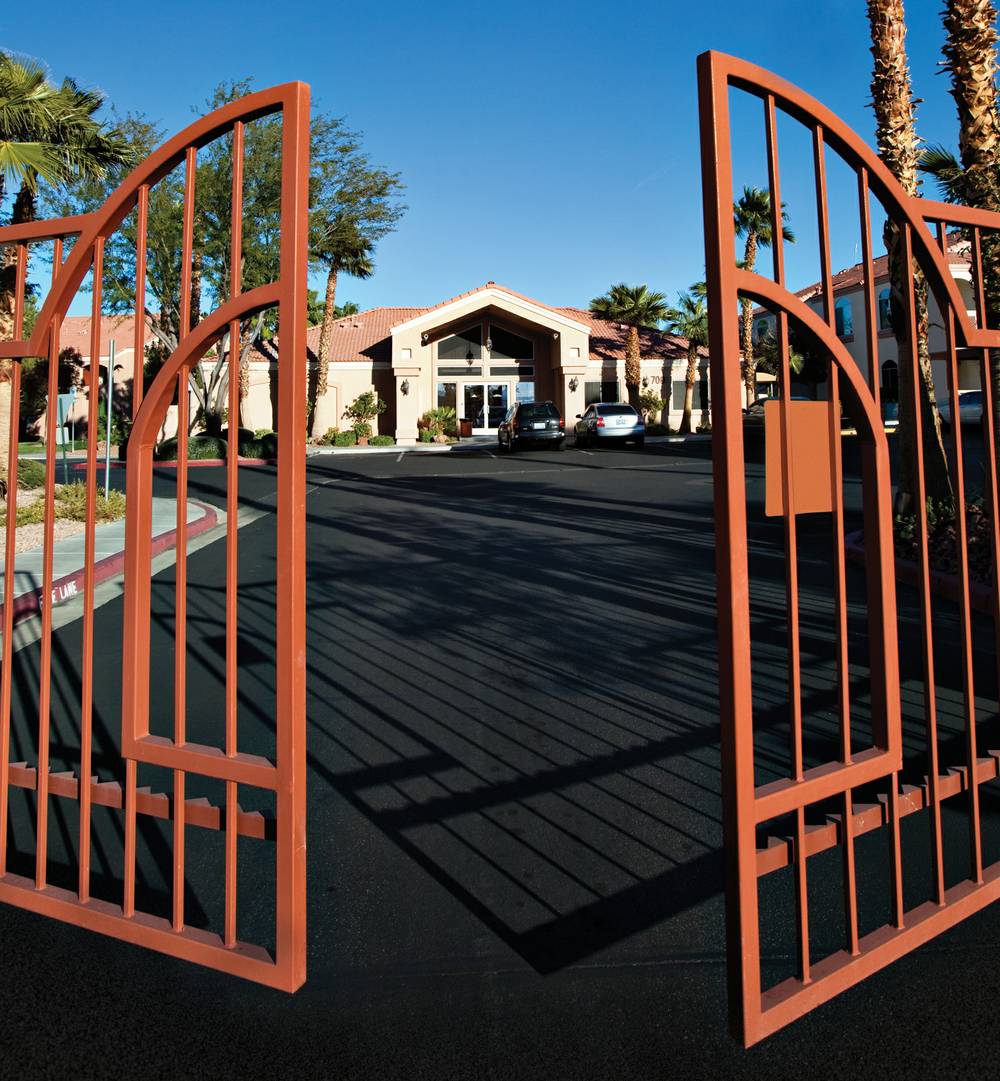I live in a gated community. That might sound prestigious, but I assure you it isn’t. I count among my neighbors the uneducated, the unemployed and the criminal. From my front door, I’ve seen flashing cop cars, hovering police helicopters, tearful arrests and dramatic drug busts.
Aren’t gated communities supposed to be exclusive suburban safe havens? Surely all my homeowners association (HOA) dollars aren’t being spent on those noisy leaf blowers that only show up when I’m asleep. Surely the slow-moving, aesthetically unpleasing iron gate erected between my condo and the rest of Las Vegas does something.
The question is, what, exactly, does it do?
The history of gated communities ties into the history of HOAs, and the history of HOAs ties into racism. Prior to the 1950s, property owners kept black people out of their neighborhoods using racially restrictive covenants. But when the Supreme Court struck this practice down in Shelley v. Kraemer (1948), white landowners moved from de jure racism to de facto.
“HOAs were a direct response to growing diversity,” says UNLV urban politics professor Kenneth Fernandez. “They created rules to keep out minorities and other unwanted social classes. In place of racially restrictive covenants, HOAs used high fees and evictions.”
Taking the segregation one step further, many HOA neighborhoods erected gates. And then, in the ’60s and ’70s, neighborhoods without HOAs began erecting them, too. “The gates,” Fernandez says, “were a response to the rapidly growing crime rates from the ’60s to 1991.”
In most of the country, crime rates have declined significantly since then. Nevada is no exception. Since 1991, murders per 100,000 residents have dropped from 12 to six, burglaries from 1,400 to 830, larcenies from 3,550 to 1,750, and vehicle thefts from 650 to 470. But only now are Nevadans and Americans beginning to grow aware of these declining crime rates. Accordingly, since 1991, the number of gated communities has risen.
Gated communities are not only the product of consumer demand, they’re also something that’s been marketed to us. Says Fernandez, “We’ve been sold this idea that gated communities are what you should want, that gated communities are safer.”
But are they?
I can’t believe nobody’s broken into my condo yet. No idea what I’ve done to deserve such good karma. Did I rescue a bus of orphans while I was asleep? Really, each morning I wake up pleasantly surprised that my Wii and laptop are right where I left them.
My community’s gate couldn’t be easier to subvert. My HOA hasn’t changed the four-digit code since I moved in two years ago. My roommate and I have given this code to nearly every pizza delivery guy and repairman in Las Vegas. And I’m sure everybody else in our condo complex has done the same. Oh, and if you want to get into my neighborhood and don’t know the code, just pull to the side of the gate and wait for somebody else to punch in the code for you. Shouldn’t take more than three minutes.
The truth is, most gated communities are not safer than their non-gated counterparts. As Officer Marcus Martin of the Las Vegas Metro Police Public Information Office points out, there’s a big difference between a gate that has guards and a gate that doesn’t. The former provides some protection, the latter doesn’t. Martin urges those who live behind gates without guards not to adopt a false sense of security. “We can never seem to make people diligent enough to lock their front doors,” he says. “A lot of home invasions begin with people just letting themselves in through unlocked doors.” Even those who live behind gates with guards should remain vigilant as many of these guards are untrained and poorly paid.
The Metro PIO and Henderson Police Department don’t have ready-to-go statistics on the crime rates in gated communities versus non-gated communities. But professor Suk-Kyung Kim published a paper at Texas A&M focused on that very issue. Kim’s research found that residents in gated communities felt safer than residents in non-gated communities, but also reported more crime. In other words, the gates offered a psychological boost, but not a warranted one.
How can this be? How can gated communities be less safe than their non-gated counterparts? Maybe it’s a product of gated community residents’ false sense of security. Unlocked doors, unlocked cars, open garages. Maybe criminals are targeting gated communities (like the thieves in Atlanta who got to 90 homes in gated communities before getting caught). Or maybe the statistics are off; the city of Miami reported that gates actually deterred car thefts and reduced the burglary rate. Then again, even Miami admits the deterrence was slight—and temporary.
America’s love affair with gates is waning. HOA fatigue is setting in, too. People are sick of the restrictions and sick of the fees. More and more buyers are choosing homes because they’re not part of HOAs. And some buyers seek to avoid gates.
Take Midwesterner Amber W. She recently moved into Pacific Trace in Green Valley Ranch. Pacific Trace has a gate, but not a guard. “The actual gate is just a heavy, prison-bar looking thing painted forest green,” Amber says. “It is entirely unembellished and reacts sluggishly to my gate clicker. It doesn’t make me feel safer. If anything, it makes me feel impatient.”
Amber didn’t want to live behind the gate; she picked the home based on location, size and price. “I felt a bit embarrassed about the gate. To me, gates are to a housing development what the Greek system is to college: an effort at exclusion that neither elevates those on the inside nor serves to endear them to those on the outside.”
As the months went by, though, Amber began to notice some positives about living in the gated community: “Perhaps it’s that our community is very condo-like, with small lots and narrow streets, but I feel an increased sense of closeness to my neighbors. I know more of my neighbors here, and I see them more frequently.”
This benefit, of course, has an equal and opposite cost. Gated communities might increase intra-community interactions, but they surely decrease inter-community interactions. And for many sociologists, these two things don’t balance each other out; when you interact with different communities, you expose yourself to people of different races, income levels and life views. This decreases racism and increases social capital.
So maybe it’s time to tear down these swinging metal walls. Their security benefit is minimal and their sociological cost is clear. I don’t know about you, but I’d rather be safe than feel safe. And while we’re at it, I’d rather spend time I waste waiting for my gate to open on sleep.
If those damn leaf blowers will let me ...


Previous Discussion: